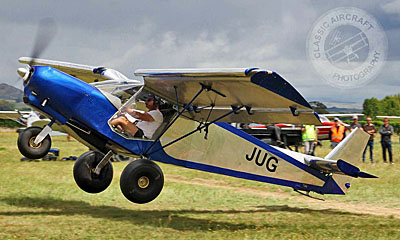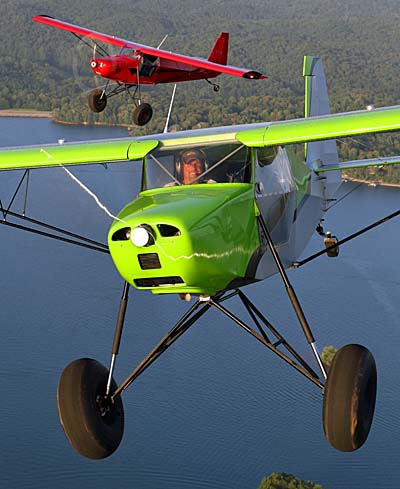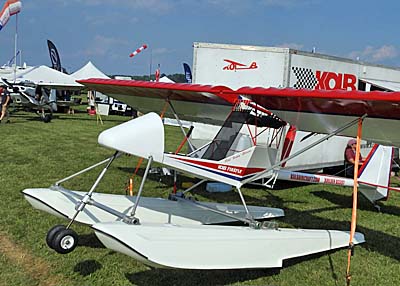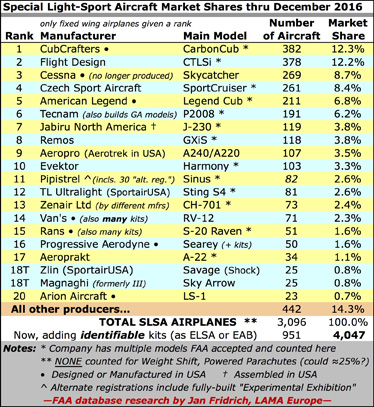 Update 1/15/19: Thanks to reader feedback — a resource we value very highly — we have updated our statistics to correct another naming challenging.
Update 1/15/19: Thanks to reader feedback — a resource we value very highly — we have updated our statistics to correct another naming challenging.
“Zodiac” turned up 53 more registrations since 2005: 52 601s and one 650. “Of the 53 additions, four were registered in 2018. That bumps our total fleet to 8,027,” wrote Steve Beste.
Check Tableau Public for the latest data. —DJ
“What about my plane,” a number of you asked? “I didn’t see [XYZ brand] of aircraft,” a few others wrote. “How come you didn’t include what I fly,” several inquired?
You spoke (or wrote). We listened.
The result? 7,974 aircraft (up from 6,305) is our refreshed count of all Sport Pilot/Light-Sport Aircraft flying machines registered in America.
My advisor and consultantant in this deep data dive, IT expert Steve Beste and I decided to enlarge the “universe.” While sticking to the 2005 date when FAA accepted the first SLSA, we can now broaden the aircraft registration database search to include brands like Kolb, Quad City, Sonex, Titan, Murphy, Aero Adventure, Sport Performance and more, plus additional kit aircraft models from companies that do both SLSA and Experimental Amateur Built (EAB) deliveries. If you think we missed any, please let us know.
Clarifying, this decision means we also include models from brands previously included but which models never went the ASTM standards compliance route.
Go Exploring — ALL the Aircraft!
To go roam around the ocean of info about light aircraft, click or tap to this NEW Tableau Public page*. On it you will find the familiar “Dashboard” as you arrive at the website. At the top of the page, look for a row of tabs. You will now find two new tabs labeled, “This-Yr Ranking” and “All-Yr Ranking.” I think they are pretty self-explanatory.

A pair of Just Aircraft SuperSTOL SPK Kits. photo by Jean-Marie Urlacher
You can still tweak these depictions any way you wish. For example, once you click on the “This-Yr Ranking” tab you will see two tables. One has a ranking by brand only. The right-hand table has ranking by model, that is, the most registered models. Then, you can go to, for example, the third blue box on the left edge and click off Kit/Other to see only SLSA or click off SLSA to see only Kit/Other entries.
The larger blue box above helps you focus on one or more selected brands. Click off “(All)” and then pick the brand or brands you want to examine. Likewise you can also select a type of aircraft (top box) or a method of FAA approval (“Choose Certification” in the fourth blue box), or zero in on amphibious aircraft in the lowest blue box.
Back on the Tableau home page, some of you found — and apparently enjoyed; we heard from several of you — that you can go find your own aircraft. Every single one of the 7,974 aircraft making up this review can be viewed. Pretty cool, huh?
Why Did We Make This Change?
Simply put, you asked and we want to be responsive. We also want to include ALL aircraft that a Sport Pilot (or someone using a higher certificate to exercise the privileges of Sport Pilot) may fly. I think we have all of them now, but if we find more, we will include them in ongoing reporting.

Kolb is a brand now counted in our more inclusive tally.
EABs and ELSA — while not demonstrating compliance to ASTM standards — are still very legitimately part of what this website endeavors to cover. Our tagline is “News & Video on Light-Sport Aircraft, light kit aircraft, and ultralight aircraft” and we mean to cover all those types. Of course, we cannot count Part 103 ultralights as they are never given N-numbers but we want to gather all the other appropriate producers and owners in our tent.
New phrase: “Sport Pilot Eligible Kits” — which I will start abbreviating as SPE Kits — denotes kit-built aircraft, either Experimental Amateur Built (EAB) or Experimental, meaning kit, Light-Sport Aircraft (ELSA). We only count kits, or SLSA, after 2005 as that’s when the first SLSA was accepted by FAA. Before that, we had no Sport Pilot certificate, so no kit aircraft model could consider itself Sport Pilot Eligible. Steve Beste and I believe our current Tableau Public page title — “Light Sport Aircraft, Sport Pilot Eligible Kits, and Modern Gyroplanes” — best reflects the energy, diversity, design variety, and uniqueness of this sector of aviation.

Our former, familiar chart of aircraft. Good as it was, we left out too many aircraft and have now solved that shortcoming while adding more groups and models.
One More Thing: Of personal satisfaction to me, this refreshed effort strengthens a claim in this chart that the USA has about 13,000 LSA or LSA-like aircraft. One difference between the 8,000 we can accurately count and which appear in Tableau Public are 4,000 or so “fat ultralights” that were converted to ELSA, a program that ended in 2010. The small difference still remaining can mostly be filled with Part 103 ultralight vehicles, so that 2015 survey looks even more solid and reliable.
I wrote “accurately” and we do believe we have done this correctly. However, when you get into kits the problem can be more difficult because a kit-built aircraft may be registered with the model name “Bob Jones Flyer,” when in fact it was an airplane built from an Avid Flyer kit but modified in ways that our theoretical Bob wanted to immortalize by assigning his name to the model. That’s perfectly OK with FAA but makes identifying it somewhat harder.
Nonetheless, we think the new-and-improved list on Tableau Public is now even more informative. This information is not well covered by anyone else but we felt it was worthwhile and we hope you agree.
* Note that Tableau presently works best on a desktop or laptop computer with a larger screen. Tableau arranges some of the data for tablets and somewhat less for smartphones as insufficient screen area exists to portray it all. Steve will be working on these mobile device presentations soon.


Thank you very much for the considerate reply, Dan. I know your goals determine what you want to cover. I am just not sure why legacy gyros are not a part of those goals. It would seem that milestones of “more sold/registered than RAF” or ” x % safer than a RAF” (or Benson) would be desirable report.
I assume one of your overall goals is to improve modern LSA sales. If statistics like these were provided, it should induce an investigative, safety-aware potential buyer to steer away from a lower cost legacy gyro in favor of a more more modern one, even if somewhat more expensive.
That said, my own pre-gyro-buy review of accident reports found that the majority of past gyro accidents were simply training related. Usually the pilot (victim) had no formal training, nor a gyro rating. But Darwin never sleeps, eh? Like heli’s, gyros are arguably more difficult to fly. Tip-overs seem just as common as ground-loops when gyros and tail draggers are compared, yet both are unrequired to report.. Those accidents that were due to mechanical failures were mostly of poor maintenance issues (missing cotter pins, etc.) ‘Tis true that a couple old RAF accidents were very likely due to a poor initial design, but a couple do not (yet) make a trend. That’s exactly why we have the AD system for standard certificated aircraft, eh?
Keep up the good work.
Hi Rob: As noted, no decision will satisfy everyone. Your comments are well received and I certainly get your point. However, I prefer not to deep dive into accident reporting, especially when I may lack knowledge. Plus, if we open up pre-2005 reporting for one aircraft category, we should do it for all. That’s one of those arbitrary lines we drew and, for now, we will stick with the decision. Again, your kind words are most appreciated.
Since my 650 got it’s airworthiness certificate in June of 2018, that must be the “one 650” you referred to…
Not to be picky, but some variations of the makes are not showing, for example my airplane is a Zenith Zodiac 601XL, but it was registered as Zodiac 601XL, there are a bunch of other Zenith that are registered using Zodiac instead…. maybe for a future update.
Why are the legacy models, specifically the RAF gyroplane, still not included? I know you wanted to show “modern” market growth, but growth is more meaningful when compared to the legacy market.
Hi Robert: We made several decisions in deciding what to cover. First, we include no airplanes before 2005 as we cover the age of LSA while including all the kit models that a Sport Pilot can fly. Secondly, FAA’s Rotorcraft group has been so oppressively negative about older-style gyroplanes that we chose not to include them, fair or not. FAA considers the accident record for older style gyros so poor that this lead to not including even modern gyroplanes in the SLSA category (a problem LAMA is working to solve). We had to draw some arbitrary lines in order to present valid, useful data and I think we did well but no solution will satisfy everyone. Thanks for your input!